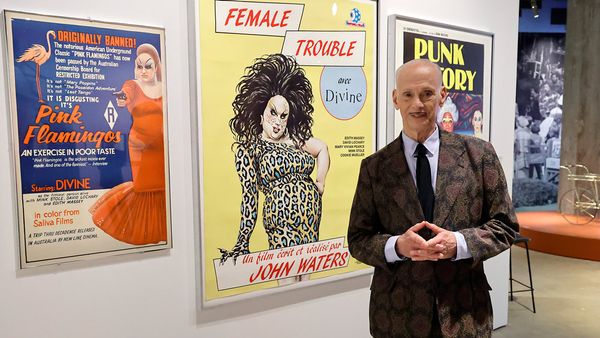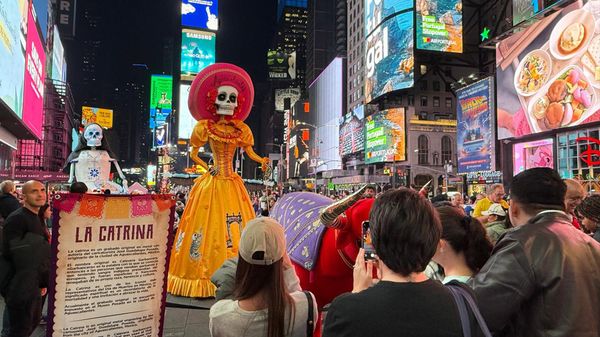
July 9, 2017
Hats Off!
Sura Wood READ TIME: 4 MIN.
There's a lot to love in the Legion of Honor's "Degas, Impressionism, and the Paris Millinery Trade," a light-hearted new summer show that connects stylish hats with hat-wearing subjects in paintings of the same era.
A multitude of gorgeous artworks are mingled with specimens of high-fashion, 19th-century Parisian millinery festooned with plumes, moire ribbons - even an iridescent purple-and-blue-green Senegalese starling - and exhibited on perches like exotic birds. It's an entrancing idea, but one can't help wishing the exhibition went deeper, and that its tantalizing embarrassment of riches had been married more successfully.
Admittedly, it's hard to knock a show with walls of Impressionist paintings, including a half-dozen Renoirs of young French girls in Breton hats wreathed with silk flowers, and a raft of sensual paintings and pastels by Degas, who was attuned to the secret lives of women. There's a sense of hushed ritual in Degas' "Woman Trying on a Hat" (1884), where a client is seen from the back inside a curtained room, a ceremonial glow emanating from the scarlet carpeting.
Among the radiant, free-handed works by Berthe Morisot is the sumptuous "Young Girl on the Grass: Mademoiselle Isabelle Lambert" (1885), an ineffably lovely portrait of her favorite model seated in a springtime garden effusive with blooms. Almost too beautiful for words, it's a picture of girlish innocence incarnate, and as it turned out, fleeting - Isabelle died at 17. And as for Renoir: well, an early biographer declared him "an erotomaniac for women's hats." The lush woman surrounded by the blur of a vivacious gathering in the artist's "At the Milliner's" (1878) might be a customer making an impulsive purchase before joining "Luncheon of the Boating Party"(1880); the latter work, though not on view, would've been the perfect occasion.
This was an age that saw the introduction of the department store, circa 1880, the rise of the modern woman, and a time when an extravagant accessory, tilted at the perfect angle, just so, was a necessity. Hats not only made the woman but men and children, who wouldn't dream of leaving the house without one poised on their heads. Men get their due in a separate gallery that includes top hats, bowlers and sporty straw boaters, an extremely popular style among men and outdoorsy women depicted in an array of posters showing them cycling and otherwise navigating a brave new world.
In keeping with the style of the day, a woman would pile her hair high and pin her piece de resistance to her coiffure, sailing forth like a proud ship out to sea. Those chic creatures, strolling the wide boulevards of Paris with hat boxes from posh boutiques slung on their arms, like the sublimely elegant shopper in Jean Beraud's "Fashionable Woman on the Champs-Elysees" (1902), must have been a sight to behold.
Visitors will be heartened to learn the hats have their own provenance (detailed in the catalogue), and that some of the women who created them became self-made millionaires. Madame Virot, for instance, started as a milliner's assistant, but by 1860 had established her own house with elite clients such as Empress Eugenie, making her one of the "most sought-after modistes in Paris." A stunning Virot affair of black silk and ostrich feathers (1905-10) is magnifique. The millinery industry spawned a mania for feathers from the French African colonies to Central America and Asia; ostrich were preferred because they could be plucked from live birds, but, as they're a notoriously cantankerous species, one wonders how cooperative they were when it came to parting with their plumage.
Inspired by 18th-century portraitist Thomas Gainsborough, spectacular picture hats were the rage for women wanting to be seen and swan around a grand soiree. A theatrical design by Madame Georgette (1910) features sheer black lace with antique rose and beige cotton flowers on its broad brim, cresting with architectural grace in the front for maximum panache. They were also perfect for a pirate, flush after a lucrative raid, or the odd swashbuckler angling to make a dramatic entrance. Michniewicz Tuvee's low-crowned, wide-brimmed, rich golden-brown rabbit felt number (ca. 1892) with matching satin ribbons, jet buckles and a double bed of pillowy ostrich feathers, screams Errol Flynn.
Drenched in femininity, the plush, sensual kind, and the emerging contingent of independent working women for whom Degas had a special affinity, a number of the show's works directly or indirectly address the class differences between low-paid millinery industry employees and the affluent customers who could afford to purchase the goods. Shop girls sold the items, and knowingly or not, were part of the luxury package. The main figure in James Tissot's "The Shop Girl" (1883-85) is as tall as the lavishly atmospheric large-scale canvas. Tissot sets the stage in an upscale haberdashery, its glass door open to a busy Paris street. Outside, a man stands beneath a striped awning, peering through the window at the willowy saleswoman in a dark fitted dress, who may have been inspired by Tissot's muse and lover who died at 28. Her hair loosely pulled into a bun, she's beside a counter strewn with colored ribbons, holding a box wrapped in peach-colored papers. Part of a projected series, "Women of Paris," the work was one of only 15 he completed; each was to be accompanied by a short story. For this painting, Tissot had chosen Emile Zola, who would have gravitated toward its subtext: longing and the loss of love.







